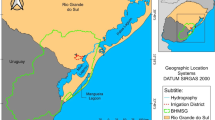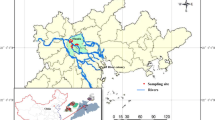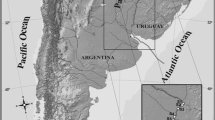Abstract
Because pesticide-contaminated water can harm living organisms, pesticide residues need to be monitored, their sources need to be identified, and the risks they pose should be assessed. In this study, the sources, fluxes, and discharges of, and risks from, pesticides were monitored and assessed during the rice-growing season (from April to October) in the Kurose and Ashida Rivers in Hiroshima, Japan. Water samples were collected monthly, subjected to solid-phase extraction, and then analyzed by gas chromatography–mass spectrometry and high-performance liquid chromatography to determine the presence and concentrations of pesticides. The fluxes of the detected pesticides were also estimated at each site in the Kurose and Ashida rivers, and the discharges of these pesticides from different sources were determined. The potential ecotoxicological risks from the detected pesticides to the aquatic systems were also evaluated. Thirteen pesticides were detected in the Kurose River. Of these, the mean concentrations of diroun (970 ng/L) and butamifos (4.7 ng/L) were the highest and the lowest, respectively. Eleven compounds were detected in the Ashida River. Again, the mean concentration of diuron (860 ng/L) was the highest, while that of flutolanil (5.5 ng/L) was the lowest. The pesticide fluxes were the highest in the Ashida and Kurose Rivers in October and May, respectively. The main sources of pesticide discharges were rice paddies, orchards, and vegetable fields. The results of the ecotoxicological risk assessment indicated that fenitrothion, diuron, dichlorvos, and benthiocarb posed high risks to the aquatic environment in the Ashida and Kurose Rivers.




Similar content being viewed by others
References
Azevedo DA, Vinhas T, Viana P, Barcelo D (2000) Monitoring the priority pesticides and other organic pollutants in river water from Portugal by gas chromatography–mass spectrometry and liquid chromatography–atmospheric pressure chemical ionization mass spectrometry. J Chromatogr 879:13–26
Blanchoud H, Farrugia F, Mouchel JM (2004) Pesticide uses and transfers in urbanised catchments. Chemosphere 55(6):905–913
Castilho JAA, Fenzl N, Guillen SM, Nascimento FS (2000) Organochlorine and Organophosphorus pesticide residues in the Atoya river basin, Chinandega, Nicaragua. Environ Pollut 110:523–533
Chidya RCJ, Abdel-dayem SM, Takeda K, Sakugawa H (2018a) Spatio-temporal variations of selected pesticide residues in the Kurose River in Higashi-Hiroshima city, Japan. J Environ Sci Health, Part B 23:1–13
Chidya RCG, Abdeldaym SM, Takida K, Sakugawa H (2018b) Spatio-temporal variations of selected pesticide residues in the Kurose River in Higashi-Hiroshima city, Japan. J Environ Sci Health B 2018:1–13
Chikushi H, Hirota K, Yoshida N, Edamura T, Toda K (2009) Simple water analysis of golf link pesticides by means of batch-wise adsorption and supercritical fluid extraction. Talanta 80:738–743
Derbalah ASH (2004) Contamination, Fate and Elimination Kinetics of Pesticide Residues in River Water, Hiroshima Prefecture. Dotoral Thesis. Hiroshima University, Japan
Derbalah ASH, Nakatani N, Sakugawa H (2003) Distribution, seasonal pattern, flux and contamination source of pesticides and nonylphenol residues in Kurose River water, Higashi-Hiroshima, Japan. Geochem J 37:217–232
Derbalah A, Chidya R, Jadoon W, Sakugawa H (2019) Temporal trends in organophosphorus pesticides use and concentrations in river water in Japan, and risk assessment. J Environ Sci 79:135–152
ECC (European Community Commission) (2003) Technical guidance document on risk assessment Part II. Joint Research Centre, Brussels
El-Kabbany Samia, Rashed MM, Zayed MA (2000) Monitoring of the pesticides levels in some water supplies and agricultural land, in El-Haram, Giza (A.R.E.). J Hazard Mater 72:11–21
Field JA, Reed RL, Sawyer TE, Martinez M (1997) Diuron and its metabolites in surface water and ground water by solid phase extraction and in-vial elution. J Agric Food Chem 45:3897–3902
Gooddy DC, Chilton PJ, Harrison I (2002) A field study to assess the degradation and transport of diuron and its metabolites in calcareous soil. Sci Total Environ 297:67–83
Hela DG, Lambropoulou DA, Konstantinou IK, Albanis TA (2005) Environmental monitoring and ecological risk assessment for pesticide contamination and effects in lake pamvotis, northwestern greece. Environ Toxicol Chem 24(6):1548–1556
Itagaki N, Nagafuchi O, Takimoto K, Okada M (2000) Fate of pesticides in a shallow reservoir. Water Sci Technol 42:217–222
Iwafune T, Inao K, HorioT Iwasaki N, Yokoyama A, Nagai T (2010) Behavior of paddy pesticides and major metabolites in the Sakura River, Ibaraki. Jpn J Pestic Sci 35(2):114–123
Iwakuma T, Shiraishi H, Nohara S, Takamura K (1993) Runoff properties and change in concentrations of agricultural pesticides in a river system during a rice cultivation period. Chem 27:677–691
Kaonga CC, Takeda K, Sakugawa H (2015) Diuron, Irgarol 1051 and Fenitrothion contamination for a river passing through an agricultural and urban area in Higashi Hiroshima City, Japan. Sci Total Environ 15:518–519
Kaonga CC, Chidya RCG, Kosamu IBM, Abdel-dayem SM, Mapoma HWT, Thole B, Mbewe R, Sakugawa H (2017) Trends in usage of selected fungicides in Japan between 1962 and 2014: a review. Int J Environ Sci Technol 15:1801–1814
Kondo K, Boulange J, Phong TH, Hiramatsu K, Inoue T, Watanabe H (2012) Probabilistic assessment of herbicide runoff from Japanese rice paddies: the effects of local meteorological conditions and site-specific water management. J Pestic Sci 37(4):312–322
Kondoh H, Fukuyama R, Liu A (2001) Simultaneous determination of pesticides and their seasonal variation in Ishikari River Basin. J Environ Chem 11:253–266 (in Japanese)
Larson SJ, Capel PD, Goolsby DA, Zaugg SD, Sandstrom MW (1995) Relation between pesticides use and riverine flux in the Mississippi river basin. Chemosphere 31:3305–3321
Ma J, Lu N, Qin W, Xu R, Wang Y, Chen X (2006) Differential responses of eight cyanobacterial and green algal species, to carbamate insecticides. Ecotoxicol Environ Saf 63:268–274
Montuori P, Aurino S, Garzonio F, Sarnacchiaro P, Polichetti S, Nardone A, Triassi M (2016) Estimates of Tiber River organophosphate pesticide loads to the Tyrrhenian Sea and ecological risk. Sci Total Environ 559:218–231
Mopper K, Zhou X (1990) Hydroxyl radical photoproduction in the sea and its potential impact on marine processes. Science 250:661–664
Nakano Y, Miyazaki A, Yoshida T, Ono K, Inoue T (2004) A study on pesticide runoff from paddy fields to a river in rural region—1: field survey of pesticide runoff in the Kozakura River, Japan. Water Res 38:3017–3022
Narushima T, Sato T, Goto Y, Takahashi Y (2014) Pesticides in river and tap water in a rice production area of Niigata, Japan. Water Air Soil Pollut 225:1–16
NIES (National Institute of Environmental Studies) (2000) Agricultural chemicals database. http://db-out.nies.go.jp/kis-plus/index_3.html
Nitschke L, Schussler W (1998) Surface water pollution by herbicides from effluents of waste water treatment plants. Chemosphere 36:35–41
Numabe A, Inoue T, Ebise S (1992) Estimation of runoff amounts of pesticides applied after transplanting of rice plant by Drainage River. J Wat Environ 15:662–671 (in Japanese)
Ohta H (2013) Historical development of pesticides in Japan. Historical development of pesticides in Japan. Survey Reports on the Systemization of Technologies 18, National Museum of Nature and Science, Japan. http://sts.kahaku.go.jp/diversity/document/system/pdf/077_e.pdf. Accessed 7 July 2016
Palma P, Köck-Schulmeyer M, Alvarenga P, Ledo L, Barbosa IR, De Alda ML, Barcelo D (2014) Risk assessment of pesticides detected in surface water of the Alqueva reservoir (Guadiana basin, southern of Portugal). Sci Tot Environ 488:208–219
Pesticide Properties Database (PPDB) (2018) University of Hertfordshire. http://sitem.herts.ac.uk/aeru/ppdb/en/Reports/1295.htm
Petroff R (2000) Water quality and pesticide performance. Education Specialist Montana State University Extension Service
Phong TK, Inoue T, Yoshino K, Hiramatsu K, Nhung DTT (2012) Temporal trend of pesticide concentrations in the Chikugo River (Japan) with changes in environmental regulation and field infrastructure. Agric Water Manag 113:96–104
Revitt DM, Ellis JB, Llewellyn NR (2002) Seasonal removal of herbicides in urban runoff. Urban Water 4:13–19
Sakai M (2003) Investigation of pesticides in rainwater at Isogo Ward of Yokohama. J Health Sci 49:221–225
Sánchez-Bayo F, Baskaran S, Kennedy IR (2002) Ecological relative risk (EcoRR): another approach for risk assessment of pesticides in agriculture. Agric Ecosyst Environ 91(1–3):37–57
Shiraishi H, Pula F, Otsuki A, Iwakuma T (1988) Behaviour of pesticides in lake kasumigaura, japan. Sci Total Environ 72:29–42
Sudo M, Kunimatsu T, Okubo T (2002) Concentration and loading of pesticide residues in Lake Biwa basin (Japan). Water Res 36:315–329
Tanabe A, Kawata K (2009) Daily variation of pesticides in surface water of a small river flowing through paddy field area. Bull Environ Contam Toxicol 82:705–710
Tanabe A, Mitobe H, Kawata K, Yasuhara A, Shibamoto T (2001) Seasonal and spatial studies on pesticide residues in surface waters of Shinano River in Japan. J Agric Food Chem 49:3847–3852
Tien CJ, Chen CS (2012) Assessing the toxicity of organophosphorous pesticides to indigenous algae with implication for their ecotoxicological impact to aquatic ecosystems. J Environ Sci Health, Part B 47:901–912
Tsuda T, Aoki S, Inoue T, Kojima M (1994) Accumulation insecticides or by the willow and excretion of pesticides used as fungicides in agricultural products shiner Gnathopogon caerulescens. Comp Biochem Physiol 107C:469–473
Tsuda T, Nakamura T, Inoue A, Tanaka K (2009) Pesticides in water and sediment from littoral area of Lake Biwa. Bull Environ Contam Toxicol 82(6):683–689
USEPA (United States Environmental Protection Agency) (2016) United States Environmental Protection Agency (USEPA) reference dose (RfD): description and use in health risk assessments background document 1A-March 15
Vryzas Z, Vassiliou G, Alexoudis C, Papadopoulou-Mourkidou E (2009) Spatial and temporal distribution of pesticide residues in surface waters in northeastern Greece. Water Res 43(1):1–10
Vryzas Z, Alexoudis C, Vassiliou G, Galanis K, Papadopoulou-Mourkidou K (2011) Determination and aquatic risk assessment of pesticide residues in riparian drainage canals in northeastern Greece. Ecotoxicol Environ Saf 74:174–181
Vu SH, Ishihara S, Watanabe H (2006) Exposure risk assessment and evaluation of the best management practice for controlling pesticide runoff from paddy fields. Part 1: paddy watershed monitoring. Pest Manag Sci 62(12):1193–1206
Wee Y, Aris AZ (2017) Ecological risk estimation of organophosphorus pesticides in riverine ecosystems. Chemosphere 188:575–581
Acknowledgements
This work was supported by Japan Society for the Promotion of Science (JSPS) KAKENHI with a Grant Number of 16KT0149. The authors are grateful to Dr. Kazuhiko Takeda, Associate Professor in Hiroshima University, for kindly helping with measuring water quality parameters. We thank Jeremy Kamen, MSc, and Deborah Ballantine, PhD from Edanz Group (www.edanzediting.com/ac) for editing a draft of this manuscript.
Author information
Authors and Affiliations
Corresponding author
Additional information
Editorial responsibility: Ta Yeong Wu.
Electronic supplementary material
Below is the link to the electronic supplementary material.
Rights and permissions
About this article
Cite this article
Derbalah, A., Tahara, K. & Sakugawa, H. Monitoring sources, discharges, and fluxes of, and assessing the risks from, pesticides in the Kurose and Ashida Rivers, Japan. Int. J. Environ. Sci. Technol. 17, 1035–1050 (2020). https://doi.org/10.1007/s13762-019-02525-x
Received:
Revised:
Accepted:
Published:
Issue Date:
DOI: https://doi.org/10.1007/s13762-019-02525-x




